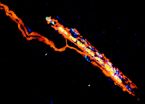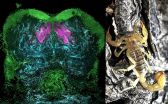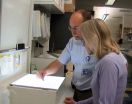(Press-News.org) RESEARCHERS have discovered the unique genetic paths that the childhood brain tumour medulloblastoma follows when the disease comes back, according to research* published in Cancer Cell today (Thursday).
The study - funded by Cancer Research UK, Action Medical Research and others** - shows that taking an extra tumour sample at recurrence, when there are no effective therapies, could identify subsets of patients that might be treatable with existing drugs that target the genetic faults.
The scientists, based at Newcastle University and The Institute of Cancer Research (ICR), looked at biopsies from the relapsed tumours of 29 patients. They found a range of changes that only appeared when the disease returned and were responsible for the cancer becoming more aggressive.
One particular combination of two genetic faults was common among a number of different subtypes, accounting for a very aggressive form of the disease.
The researchers then looked for ways to treat relapsed medulloblastomas in mice and were able to slow the growth of the tumour with an experimental drug that targets one of the faults.
Professor Steve Clifford, joint lead researcher based at Newcastle University, said: "Our study shows that we need to understand and treat relapsed medulloblastoma in a completely new way. It's clear that new biopsies need to be taken when the disease returns to give doctors a clearer picture of the best and most appropriate treatment."
Around 60-70 per cent of children survive medulloblastoma, but for those patients who relapse the chance of survival is less than five per cent.
Dr Louis Chesler, Team Leader in Paediatric Solid Tumour Biology and Therapeutics at The Institute of Cancer Research, London, said: "We were very pleased to show in our study that some children with relapsed medulloblastoma could benefit from currently available targeted drugs, which usually have fewer and less severe side effects than traditional chemotherapy. It gives us a recipe to direct the use of targeted medicines in relapse where they are most needed.
"To personalise treatment to those who might benefit, doctors will need access to tumour samples as soon as children develop relapsed disease. Tumour biopsies are not routinely taken in these situations currently - and that will have to change before we can match the best treatments to the children who desperately need them."
Professor Peter Johnson, Cancer Research UK's chief clinician, said: "We urgently need new treatments that are effective in relapsed medulloblastoma - there are too few effective options that doctors can use. We're learning more all the time about how cancers evolve and change - in the short term this work will mean that doctors can decide on the most appropriate palliative care options for medulloblastoma but more importantly the research will lead to better treatments in the future."
INFORMATION:
*Hill, R.M. et al Combined MYC and TP53 defects emerge at medulloblastoma relapse and define rapidly progressive, therapeutically targetable disease Cancer Cell
**The study was also funded by Sparks, The Brain Tumour Charity, the JGW Patterson Foundation and Christopher's Smile. The study was part of the INSTINCT network co-funded by the Brain Tumour Charity, Great Ormond Street and Children with Cancer UK.
There are two main families of bacteria : those that are surrounded by a single membrane (or one outer wall) and those that are surrounded by two membranes (or two outer walls). The team of Jean-François Collet, professor at the de Duve Institute at UCL, looked at this second type of bacteria.
For a bacterium to survive, it has to keep its two outer walls intact. If one of these walls is damaged, the bacterium dies. So it was vital for the UCL researchers to analyse the protection mechanisms of these bacterial "walls' (to find their weak spot), so as to be able to ...
This latest research by Joshua Brickman and his research team from Danish Stem Cell Center (Danstem) at the University of Copenhagen specifically found that inhibiting or blocking stem cells ability to make a specific decision, leads to better cell growth and could lead to defined ways to differentiate stem cells.
This research is the first comprehensive analysis of a pathway important for stem and cancer cell decisions known as Erk. As a result this work could contain clues to cancer treatment as well as helping to establish a platform to make stem cell treatments for ...
After an incomplete spinal cord injury, the body can partially recover basic motor function. So-called muscle spindles and associated sensory circuits back to the spinal cord promote the establishment of novel neuronal connections after injury. This circuit-level mechanism behind the process of motor recovery was elucidated by Prof. Silvia Arber's research group at the Biozentrum, University of Basel and the Friedrich Miescher Institute for Biomedical Research. Their findings may contribute to designing novel strategies for treatment after spinal cord injuries and have ...
Walter and Eliza Hall Institute researchers have for the first time revealed how dying cells are hidden from the immune 'police' that patrol the body.
The research answers a decades-old mystery about the death of cells, which in some situations can alert the immune system to potential danger, but in other circumstances occurs 'silently', unnoticed by immune cells.
Silent cell death, or apoptosis, is a controlled way for the body to eliminate cells that may be damaged, old, or surplus to the body's requirements, without causing collateral damage. This 'normal' cell death ...
This news release is available in Spanish. The genome is the cell's book of instructions. All the cells in our body contain the same genomic information but each of them "reads" the gene fragments that interest them in order to carry out their function. So, neurones, hepatocytes and cardiac cells are different although their genome is the same. In order to achieve this huge variety of functions from the same genome, the cells employ a mechanism known as alternative splicing. This enables them to combine several fragments - known as exons - from the same genes in order ...
Mountain View, Calif. - December 18, 2014 - 23andMe, Inc., the leading personal genetics company, today announced the publication of a study that pinpoints fine-scale differences in genetic ancestry of individuals from across the United States.
Since immigrants first arrived more than four hundred years ago, the United States has served as a meeting place for peoples from different continents. This study illuminates how American history and the ongoing mixing of peoples with African, European, and American origins can be seen in our DNA.
"The relationship between genomics ...
HOUSTON - (Dec. 18, 2014) - Cars that run on natural gas are touted as efficient and environmentally friendly, but getting enough gas onboard to make them practical is a hurdle. A new study led by researchers at Rice University promises to help.
Rather than shoehorn bulky high-pressure tanks like those used in buses and trucks into light vehicles, the Department of Energy (DOE) encourages scientists to look at new materials that can store compressed natural gas (CNG) at low pressure and at room temperature. Cage-like synthetic macromolecules called metal organic frameworks ...
LA JOLLA, CA--December 18, 2014--Collaborating scientists from The Scripps Research Institute (TSRI) and the University of California (UC) San Diego have developed a powerful new system for studying how proteins and other biological molecules form and lose their natural folded structures.
Using the new system, researchers can force a sample of molecules to unfold and refold by boosting and then dropping the temperature, so quickly that even some of the fastest molecular folding events can be tracked.
"One way of studying these structures has been to make them unfold ...
Whether you're cramming for an exam or just trying to remember where you put your car keys, learning and memory are critical functions that we constantly employ in daily life.
It turns out that the structure and function of brain centers responsible for learning and memory in a wide range of invertebrate species may possibly share the same fundamental characteristics, according to a new study published in the journal Current Biology and performed by University of Arizona neuroscientists Nicholas Strausfeld, Regents' Professor in the Department of Neuroscience, part of ...
ST. LOUIS - Saint Louis University research findings published in the December issue of Antimicrobial Agents and Chemotherapy report a family of molecules known as nucleotidyltransferase superfamily (NTS) enzyme inhibitors are promising candidates for new herpes virus treatments.
The findings could lead to new treatment options for herpes that patients can use in conjunction with or instead of currently approved anti-viral medications like Acyclovir. Researcher Lynda A. Morrison Ph.D., professor of Molecular Microbiology and Immunology at Saint Louis University, likened ...





